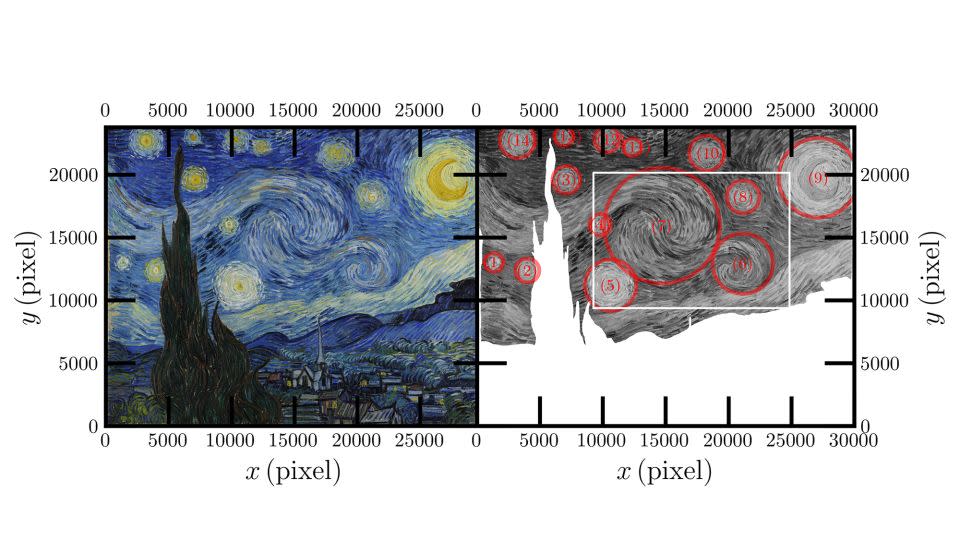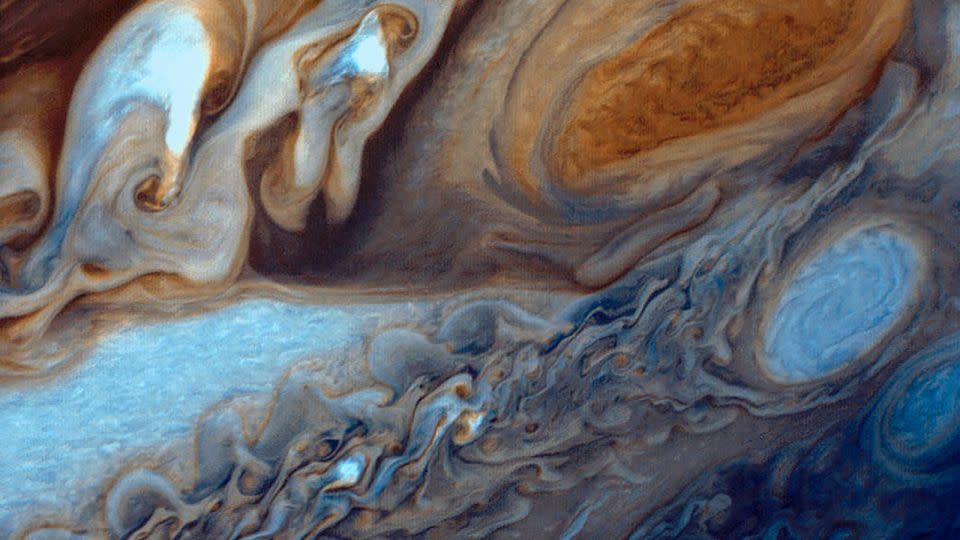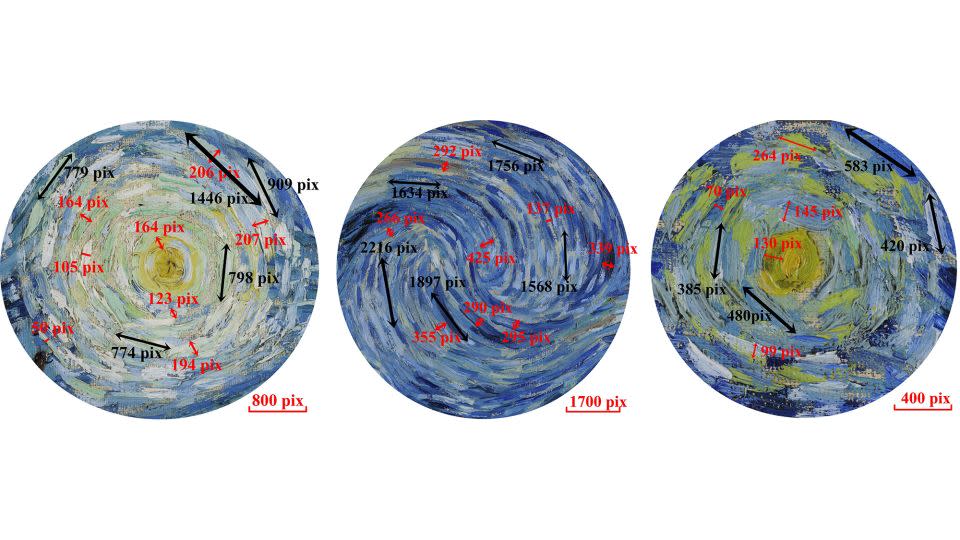Sign up for CNN’s Wonder Theory science newsletter. Explore the universe with news about fascinating discoveries, scientific developments and more.
The dappled starlight and swirling clouds in Vincent van Gogh’s painting The Starry Night are thought to reflect the artist’s tumultuous state of mind when he painted the work in 1889.
Now, a new analysis by physicists from China and France suggests that the artist had a deep, intuitive understanding of the mathematical structure of turbulent flow.
Turbulent flow is a common natural phenomenon observed in fluids (moving water, ocean currents, blood currents, billowing storm clouds, and smoke plumes). Turbulent flow is chaotic, as larger eddies or whirlpools form and break up into smaller ones.
To the casual observer, turbulence may appear random, but it nevertheless follows a cascading pattern that can be studied and, at least partially, explained using mathematical equations.
“Imagine you’re standing on a bridge and you’re looking at the river flowing. You see eddies on the surface, and these eddies are not random. They arrange themselves into specific patterns, and these kinds of patterns can be predicted by the laws of physics,” said Yongxiang Huang, lead author of the study published Tuesday in the journal Physics of Fluids. Huang is a researcher at the State Key Laboratory of Marine Environmental Science & College of Ocean and Earth Sciences at Xiamen University in southeast China.
“The Starry Night” is an oil on canvas painting that, the study noted, depicts a view just before sunrise from the east-facing window of the artist’s room in Saint-Rémy-de-Provence in southern France, where Van Gogh had committed himself to a psychiatric institution after mutilating his left ear.


Using a digital image of the painting, Huang and his colleagues examined the scale of the 14 main swirling shapes to see if they matched physical theories that describe the transfer of energy from large to small vortices as they collide and interact.
‘The Starry Night’ and Turbulence Theories
The atmospheric motion of the painted sky cannot be measured directly, so Huang and his colleagues measured the brushstrokes precisely and compared the size of the brushstrokes to the mathematical scales expected from turbulence theories. To measure physical motion, they used the relative brightness, or luminance, of the varying paint colors.
They discovered that the size of the 14 eddies, or whirlpools, in The Starry Night, and their relative distance and intensity, follow a physical law governing fluid dynamics known as Kolmogorov’s theory of turbulence.
In the 1940s, Soviet mathematician Andrei Kolmogorov described a mathematical relationship between the fluctuations in the velocity of a flow and the rate at which its energy dissipates.


Huang and the team also found that, at the smallest scale, the paint mixes with some background swirls and eddies in a way predicted by turbulence theory, following a statistical pattern known as Batchelor’s scaling. Batchelor’s scaling mathematically represents how small particles, such as floating algae in the ocean or bits of dust in the wind, are passively mixed by turbulent flow.
“This is cool. These are indeed the kind of statistics you would expect from algal blooms swept along by ocean currents, or dust and particles in the air,” James Beattie, a postdoctoral researcher in the department of astrophysical sciences at Princeton University in New Jersey, said in an email. Beattie was not involved in this study but has done similar research on the artwork.
“In my paper I really only looked at the large (swirls in the painting), so I didn’t see this second relationship,” he said, referring to Batchelor’s scaling.
‘A wonderful coincidence’


Huang said Van Gogh was not aware of such comparisons, but he likely spent a lot of time observing turbulence in nature.
“I think this physical relationship must be anchored in his mind and that’s why he made this famous painting ‘Starry Night’, imitating the real flow,” Huang said.
Beattie agreed: “It’s an astonishing coincidence that Van Gogh’s beautiful painting shares many of the same statistics as turbulence,” he said.
“This makes some sense — the models are constructed to capture the statistics of eddies and vortices at multiple scales, with each eddy communicating with other eddies through the turbulent cascade. In a sense, Van Gogh painted something that represents this phenomenon, so why shouldn’t there be convergence between the theoretical models and the statistics of Van Gogh’s eddies?”
The research team performed the same analysis and discovered the same phenomenon in two other images, one of a painting, “Chain Pier, Brighton”, made by British artist John Constable in 1826-7, and the other a photograph of Jupiter’s Great Red Spot taken by NASA’s Voyager 1 space probe on March 5, 1979.
“In contrast to ‘The Starry Night’, this painting lacks clearly defined swirling patterns, but the clouds are rich in structures of varying scales, resembling those often seen in the sky,” the study of Constable’s artwork said.


“The Starry Night” is a hugely popular work of art on display at the Museum of Modern Art in New York and has been recreated using Lego bricks, drones and dominoes.
Huang said scientists have long struggled to describe turbulent flow in fluid dynamics in a way that would allow them to predict the phenomenon, and that a full explanation remains a persistent mystery of physics. A thorough understanding would help with weather forecasting, flight turbulence and many other processes, he said.
“Even after more than 100 years (of) study, we still don’t know how to define this complex phenomenon,” Huang said. “It’s extremely important, but it’s extremely difficult.”
The fact that “The Starry Night” matched statistical models of turbulence, even though the artwork is not actually moving, could suggest that statistical methods and tools are less accurate than scientists may have thought, Beattie said.
The painting can’t be measured precisely because “it’s not really turbulence. … It has no kinetic energy,” he said.
However, Beattie said he was a big fan of the artwork and that it reflected the universality and beauty of turbulence.
“I’m excited to be able to apply my knowledge of plasma turbulence between galaxies to turbulence between stars, between the Earth and the Sun, or in our own lakes, oceans and atmospheres,” he said.
“What I take away from studies like this is that (van Gogh) captured something of this universality in the beautiful (‘Starry Night’),” Beattie added. “And I think people know that. They know that there’s something miraculous embedded in this painting and that we’re drawn to it.”
For more CNN news and newsletters, create an account at CNN.com
